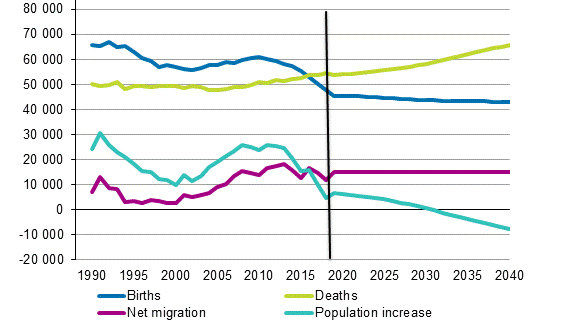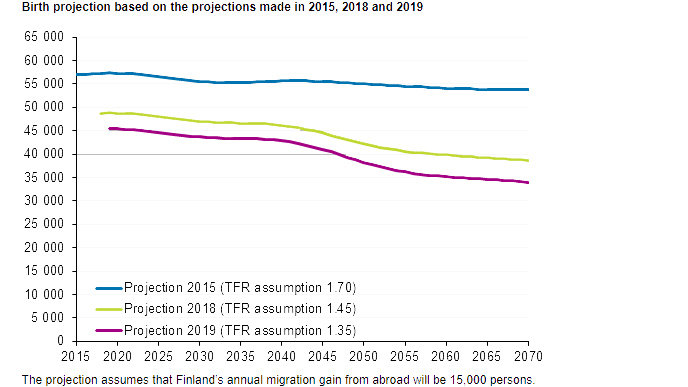The latest population projection published by Statistics Finland confirms what experts have been warning in recent years: if Finnish people are not capable to increase their birth rate, in less than two decades the country's population will start decreasing. In fact, the birth rate has been falling year after year during this decade, so if Finland is not yet loosing population it is thanks to net population gain derived from immigration.
Statistics Finland's 2019 population projection is based on the assumption that the current fertility rate (1.35 children born per woman) will remain unchanged.
That poor result already had consequences in 2018. The population increased only in four regions and in Åland. If things remain unchanged, the statistical office predicts that the population would only grow in the regions of Uusimaa and Pirkanmaa, and in Åland by 2035. And by 2040, the population in Mainland Finland would only grow in the region of Uusimaa and even there only due to immigration gain.

Source: Statistics Finland.
In 2018, there were 60 municipalities in Finland were births exceeded deaths. According to the projection, that would only happen in 35 municipalities in 2030 and just in 12 by 2040.
Higher life expectancy
On the other hand, mortality is assumed to continue declining similarly to what has been detected when comparing the mortality for 1987 to 1991 and 2014 to 2018. The life expectancy of men is estimated to rise by good five years and that of women by close on four years by 2040.
When comparing the 2019 population projection with the ones made in 2015 and 2018 the biggest differences, in addition to the population development, are seen in the projected development of young people in the short term and of the working age population in the long term.
According to the 2019 projection, the number of persons aged under 15 would be 688,000 in 2040 which is 178,000 less than in the 2015 projection and 47,000 less than in the 2018 projection.

Source: Statistics Finland.
Less working age population
The number of the working age population (aged 15 to 64) was highest in Finland in 2009, when there were 3.55 million such persons. During 2010 to 2018, the number of working-age people has fallen by 122,000 persons. During the next two decades, the working age population is expected to decrease more slowly or by 111,000 persons by 2040.
The reduction in the number of working age people would accelerate in the 2040s due to a drop in the birth rate. During 2041 to 2050, the working age population would decrease by 132,000 persons and in 2051 to 2060 further by 163,000 persons. At the end of 2060, the working age population would be 3.19 million persons, which is good 400,000 fewer than currently.
The proportion of working age people in the population is currently 62%. According to the projection, the proportion will drop to 60% by 2040 and to 57% by 2060. In the 2019 projections, the proportion of people of working age in total population is higher than in the two previous projections until 2060 because the population makes a downturn earlier due to the lower birth rate.










